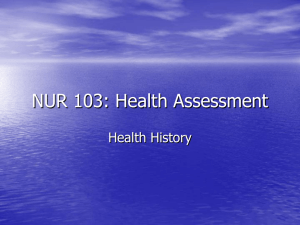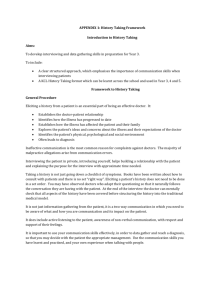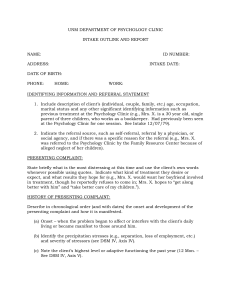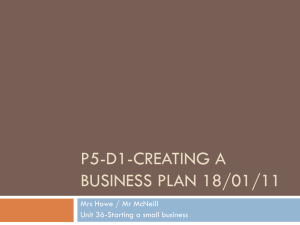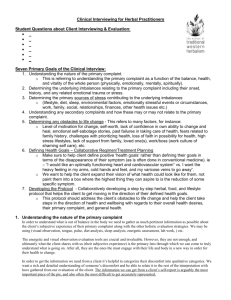Data/Sites/6/media/historytakingppt - Evault UWE E
advertisement
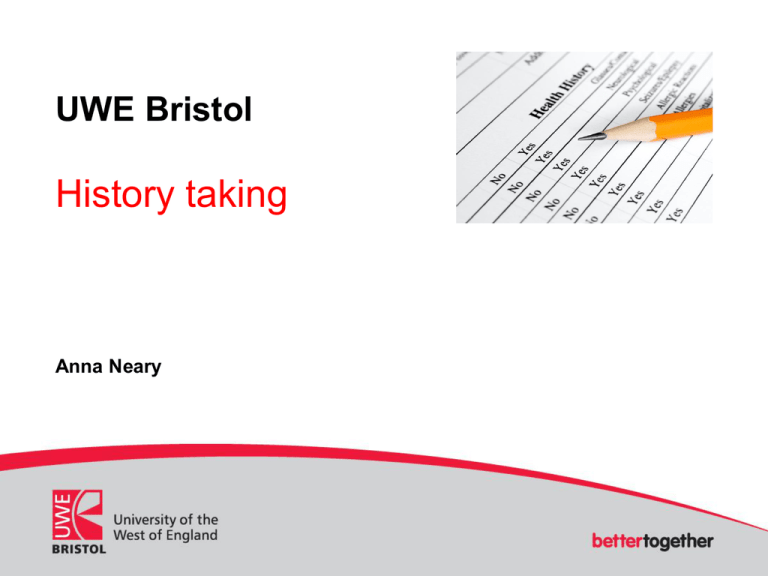
UWE Bristol History taking Anna Neary History taking Introduction It is essential to complete this learning activity after completing the Consultation models and skills activity and prior to any physical assessment activities within Enhanced clinical assessment and reasoning unit. This learning activity looks at the essential components for effective History taking when assessing patients. The activity also looks at the role of environment in taking an effective history, exploring tools to aid the process and addressing the legal aspects of history taking and documentation. In this activity, you will: 1. Review the sequence of a history taking interview. 2. Explore the importance of the environment when taking a history. 3. Explore the history taking format and tools that can be used to aid this process 4. Address the format of documentation. 5. Be introduced to the legal aspects of history taking and documentation. History taking Taking a history Taking a history from a patient is the start of an important process for the patient and the health care professional. It is a conversation with a purpose and as a health care professional you will use many interpersonal skills to make sure you establish all relevant information in order to improve the health of your patient. Thus the conversation has three aims: 1. To provide a trusting and supportive relationship 2. To gather information 3. To give information (Hogan-Quigley et al 2012) History taking Sequence of interview The sequence of the interview should be as follows: •Greeting, establish rapport •Invite the patient’s story •Establish the agenda for interview •Clarify story – generate and test diagnostic hypotheses •Create shared understanding of problem •Negotiate a plan and follow-up •Close the interview (Hogan-Quigley et al 2012) Examples of history taking processes in clinical areas include: •Admission of patient •Pre-op assessment •Triage assessment History taking History taking setting It is important to make the patient feel comfortable whilst taking their history. Factors to consider include: Comfort for all involved Removal of physical barriers Good lighting Privacy Relative quiet Unobtrusive access to clock (Douglas et al 2009) History taking Your approach to history taking History taking is one of the most important skills a health care professional has, without it assessment of health needs becomes very difficult. You want your patient to tell you potentially very personal honest facts about their health, this can only be achieved if you ask questions in a manner that is not judgmental or assuming. Patients are often fearful about their health and your role is to provide a strong nurse-patient relationship to reduce fears and feelings of isolation. History taking information is subjective data i.e. what the patient tells you. History taking Preparing for the interview As with all things it is important to prepare for taking a patients history, below is a list of the key areas you should cover before commencing your interview with the patient: Time for self reflection – what values, assumptions, biases do you bring? Review the notes Set interview goals Think about your behavior and appearance Set the environment Take notes Timings History taking Structure of the history It is important to create a structured plan to history taking. This will ensure that details are not overlooked. Areas to consider are: • • • • • • • Reason for seeking health care (Presenting complaint) History of presenting complaint (patient’s account of presenting complaint) Systematic review of body systems. Drugs and allergies (including over the counter medication) Past history (surgeries/medical diagnoses) Family history (genetics, medical/surgical) Social history (environment, relationships) (Rushforth 2009) History taking Presenting complaint This outlines the reason why the patient is seeking health care and should consist of two to three words. For example: • Central chest pain • Abdominal pain • Pain in ankle • Shortness of breath History of presenting complaint (HPC) Mnemonics help shape stories; these will help you not to omit details in the history taking and documentation process. OLDCART is a mnemonic that can be used to help take the history of presenting complaint (Douglas et al 2009). O • Onset (When did the pain begin?) L • Location (Where is the pain, does it go anywhere else?) D • Duration (How long does the pain last? Is it constant or intermittent?) C • Characteristics (Is the pain sharp, shooting, burning, electrical? Is it a dull, aching or grinding pain? Does the pain feel like cramping or squeezing?) A • Aggravating factors (Do activities like moving, walking, sitting, turning or touching worsen the pain?) R • Relieving factors (What medical and non medical interventions relieve the pain?) T • Treatment (What treatment has the patient tried e.g. heat, elevation, simple pain relief, rest?) History taking THREAD THREAD is a mnemonic used for past medical history, it reminds you to enquire about significant illnesses: •T – TB •H – Hypertension •R - Rheumatic Fever •E – Epilepsy •A – Asthma •D – Diabetes (Douglas et al 2009) Drug and Allergies Prescribed drugs include the name, dose and route and frequency of use. You must also ask about over the counter medicines including herbal remedies. History taking Systematic review of systems Understanding the review of systems can be a difficult concept to get right. You will be asking a series of questions going from head to toe, you are trying to find clues in the form of symptoms to help you come to a diagnosis. Here are the questions you would need to ask for the review of the main systems: Respiratory system – Do you ever get short of breath? – How many pillows do you sleep with at night? – How far can you walk before you get short of breath? – Do you have a cough? – Do you cough up any sputum? (Hogan-Quigley et al 2012) Cardio-Vascular System • Do you ever get any chest pain? • Do you ever get any palpitations? • Do you ever get short of breath? • Do you ever have swollen ankles? Gastro-intestinal system • How regular do you have your bowels open? • What do your stools look like? • Do you have any vomiting or diahorrea? • How is your appetite? • Have you had recent weight lose? (Hogan-Quigley et al 2012) History taking Family History It is important to establish whether there are any genetically transmitted diseases within families, these include, coronary artery disease, hypertension, elevated cholesterol disease, stroke, diabetes, thyroid or renal disease, arthritis, tuberculosis, asthma or lung disease, headache, seizure disorder, mental illness, suicide, substance abuse and allergies Social history It is important to also establish the context in which the patients live as such factors can have an impact on an individual’s health. Such as occupation, drug (illicit) and alcohol consumption, hobbies, family situation and domestic violence. Documentation Documentation is a piece of writing that accuracy reflects patient care. It ensures safety for the patient and a record of events. It is important that these records are performed soon after the patient/nurse assessment to ensure accuracy. See appendices for a template to support your documentation of a patient’s history. History taking Summary You have now completed this activity. Here is a summary of the main points: • You have looked at the sequence of history taking in the context of the medical model. • You have learnt about the importance the environment when taking a history • You have looked at mnemonics to aid the history taking process i.e. OLDCART and THREAD • You have looked at the format in which to document your history taking. • Your guided learning will lead you through the legal aspects of documentation History taking References • Dimond B (2008) 5rd Ed Legal Aspects of Nursing London : Prentice Hall NMC (2010) Guidelines for records and record keeping. NMC : London Douglas, G, Nicol, F and Robertson, C (2009) Macleod’s Clinical Examination. Churchill Livingstone Hogan-Quigley, B, Louise Palm, M, Bickley, L (2012) Bates’ Nursing Guide to Physical Examination and History Taking. First Edition. Lippincott, Williams and Wilkins. Rushforth, H (2009) Assessment made incredibly easy. First UK Edition. Lippincott, Williams and Wilkins History taking Guided Learning (three hours) 1. Take a history from five patients using the OLDCART mnemonic, for history of presenting complaint, THREAD for past medical history and use the template below to document your findings. 2. Look back at the notes you made previously in this activity to guide your approach and questions. 3. Read the PDF documents Record Keeping Guidance and NHS Information Governance and summarize the guidelines for good documentation. Discuss your findings with your supervisor.
